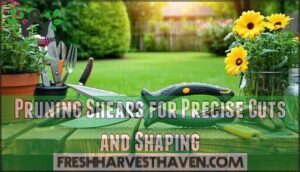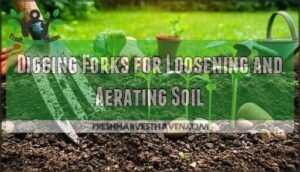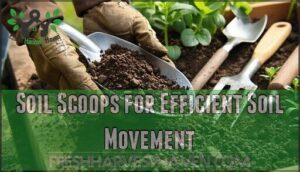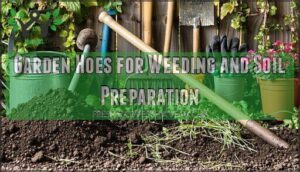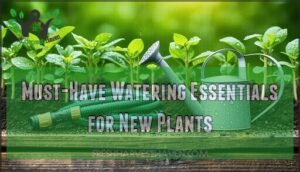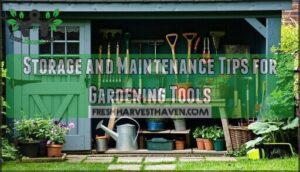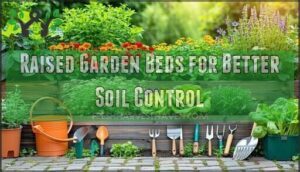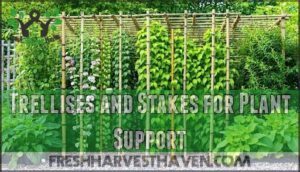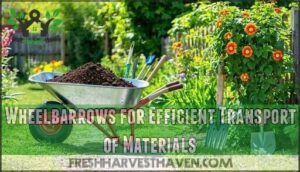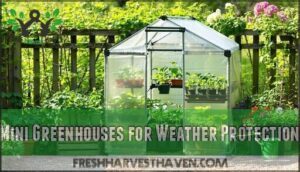This site is supported by our readers. We may earn a commission, at no cost to you, if you purchase through links.
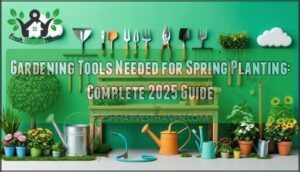
Don’t forget watering essentials like adjustable nozzle hoses and watering cans for precise irrigation of delicate seedlings. Drip systems can slash water usage by 40-70% while keeping plants consistently hydrated.
Add wheelbarrows for hauling materials and trellises for climbing plants. Protective gear including waterproof boots and durable gloves keeps you comfortable during those marathon planting sessions. Smart tool organization and maintenance tips can transform your gardening efficiency.
Table Of Contents
- Key Takeaways
- Essential Hand Tools for Spring Gardening
- Must-Have Watering Essentials for New Plants
- Storage and Maintenance Tips for Gardening Tools
- Large Equipment and Support Accessories
- Protective Gear for Safe and Comfortable Gardening
- Frequently Asked Questions (FAQs)
- What tools does a beginner gardener need?
- When should I do spring gardening?
- What are the tools used in gardening?
- What tools do you need to start a flower garden?
- What are the 9 gardening tools?
- What equipment is used for planting?
- How to choose eco-friendly gardening tools?
- When to replace versus repair tools?
- Best tools for container gardening?
- Tools needed for composting systems?
- Conclusion
Key Takeaways
- You’ll need sharp pruning shears, digging forks, and soil scoops as your core hand tools to tackle precision cuts, soil loosening, and transplanting tasks efficiently.
- Don’t skip watering essentials like adjustable nozzle hoses and drip irrigation systems, which can cut water usage by 40-70% while keeping seedlings consistently hydrated.
- Invest in protective gear, including waterproof boots, durable gloves, and knee pads, to stay comfortable and injury-free during marathon planting sessions.
- Keep your tools sharp and rust-free through proper cleaning and oil maintenance – clean tools make cleaner cuts that heal faster and extend tool life significantly.
Essential Hand Tools for Spring Gardening
You’ll need the right hand tools to transform your spring garden from winter’s leftover mess into a thriving plant paradise.
These essential tools make soil preparation and planting tasks faster and more precise.
Pruning Shears for Precise Cuts and Shaping
Pruning Shears reveal your garden’s potential through precise cuts and expert shaping. These essential gardening tools deliver cutting precision that transforms plant health and appearance.
Select bypass-style Hand Pruner models for clean cuts that heal quickly. Sharp blades slice through stems without crushing delicate tissue.
- Shear Selection: Choose ergonomic grips that fit your grip size perfectly
- Pruning Techniques: Cut at 45-degree angles just above outward-facing buds
- Blade Maintenance: Clean after each use to prevent disease spread
- Garden Shaping: Remove dead growth first then shape for desired form
Quality Hori Hori Knife pairs well with shears for complete gardening tool coverage.
Digging Forks for Loosening and Aerating Soil
Once you’ve completed your precision pruning, it’s time to tackle compacted soil. A digging fork becomes your soil’s best friend when loosening and aerating without destroying root systems. Garden tines penetrate deeper than traditional spades while preserving soil structure.
Soil Aeration benefits:
- Four-tine design creates air pockets that boost root health and water penetration
- Fork grips provide leverage for breaking through tough clay and compacted earth layers
- Soil loosening techniques prevent damage to existing plants during spring preparation
Digging techniques with garden forks beat hand trowels for larger areas. The forked design lifts soil gently rather than chopping through it like garden hoes.
Soil Scoops for Efficient Soil Movement
Soil scoops transform tedious dirt movement into smooth gardening tasks. These digging tools feature ergonomic grips that reduce strain during soil mixing and compost turning. Choose aluminum for lightweight jobs or steel for heavy-duty garden tilling.
- Precision control lets you measure fertilizer amounts perfectly every time
- Easy soil aeration happens when you scoop and turn compacted earth
- Speed boost cuts your planting prep time in half compared to hand trowels
Garden Hoes for Weeding and Soil Preparation
Choose the right garden hoe to transform your soil preparation and weeding tasks. Different blade types tackle specific jobs. Sharp blades slice through weeds while loosening compacted earth. Soil aeration improves with regular hoe maintenance. Garden rakes complement hoes for complete soil turning. Essential gardening tools work together for successful weed control.
Hoe Blade Types Best For
Regular maintenance tips keep blades sharp!
Must-Have Watering Essentials for New Plants
You’ll need reliable watering tools to keep your spring seedlings thriving through those vital first weeks.
Choose from garden hoses with adjustable nozzles for versatility or watering cans for precise control over delicate new growth.
Garden Hoses With Adjustable Nozzles for Flexibility
Your garden hose paired with an adjustable nozzle transforms watering from guesswork into precision. Choose models with multiple spray patterns for versatility. Water pressure control prevents seedling damage while delivering strong streams for cleaning tasks.
Top garden hose features to prioritize:
- Hose Materials – Rubber construction resists kinks better than vinyl options
- Nozzle Adjustments – Seven spray patterns handle everything from misting to jet washing
- Hose Nozzle Tips – Metal construction outlasts plastic alternatives by years
Quality watering wand attachments extend your reach without bending. Garden sprayer connections should seal tight to prevent leaks and pressure loss.
Watering Cans for Controlled Irrigation
While garden hoses cover broad areas, watering cans deliver surgical precision for your spring seedlings. These watering containers put you in complete control of soil moisture levels.
Choose metal construction for outdoor durability or lightweight plastic for indoor convenience. A good watering can features comfortable grips and balanced weight distribution to prevent hand fatigue during extended sessions.
Capacity matters for water conservation. One-gallon models work perfectly for small gardens while three-gallon versions reduce refill trips. Long spout designs target specific plants without disturbing nearby seedlings.
Metal Construction
Plastic Design
Long Spout Types
Rose Attachments
Large Capacity
Master proper garden hydration by tilting gradually and maintaining steady flow. This technique ensures even soil saturation without shocking delicate root systems or washing away seeds.
Drip Irrigation Systems for Water Efficiency
You’ll discover drip irrigation systems deliver water directly to plant roots with exceptional precision. These watering equipment solutions reduce water consumption by 40-70% compared to traditional garden hose methods.
Drip irrigation systems slash water use by up to 70% while delivering water straight to plant roots with surgical precision
Here’s how drip irrigation kit components transform your watering approach:
- Water Conservation – Achieve 90% efficiency versus conventional watering can methods at 65-75%
- System Design – Plastic tubing with emitters controls precise flow rates for each plant
- Installation Tips – Position emitters near root zones for maximum coverage and efficiency
- Maintenance Schedule – Clean emitters monthly to prevent clogging and maintain peak performance
- Plant Health – Consistent moisture encourages deeper root development and reduces disease risk
This watering wand alternative operates at low pressure, minimizing foliar moisture that causes plant diseases. The system prevents water stress while reducing weed growth in surrounding soil areas. By using a water efficient system, gardeners can refine their watering approach and promote healthy plant growth.
Rain Barrels for Sustainable Water Collection
Rainwater harvesting through rain barrels cuts your water bills by $35 monthly during summer. These barrel materials capture 1,200 gallons from one inch of rainfall on standard roofs. Position your watering container near downspouts for easy installation tips. Lift barrels to boost water pressure for your watering can and garden irrigation systems.
This watering equipment promotes cost savings while encouraging water conservation and sustainable gardening practices. By using a water conservation system, homeowners can reduce their environmental impact and lower their water bills.
Storage and Maintenance Tips for Gardening Tools
You’ll save hours of spring prep time by maintaining your tools properly through winter storage. Clean tools prevent rust while sharp blades make every cut easy when planting season arrives.
Proper Cleaning to Prevent Rust and Damage
The secret to tool longevity lies in proper cleaning after each use. Remove dirt and plant debris with a stiff brush. Wipe metal cleaning surfaces with a damp cloth to eliminate moisture. Apply thin coats of rust prevention oil to all metal parts.
For handle maintenance, sand rough spots and treat wood with linseed oil. Tool sanitizing prevents disease spread between plants. Use rubbing alcohol on pruning shears and other cutting tools.
Store clean gardening tools in dry locations. These storage tips and gardening tool essentials guarantee your tool storage solutions protect your investment for years.
Sharpening Tools for Optimal Performance
Sharp gardening tools make cleaner cuts that heal faster. These gardening tool essentials reduce strain and improve plant health through precise cuts.
Use file types like bastard files for rust removal first. Maintain original sharpening angles – usually 45 degrees for hori hori knife blades.
Honing techniques require steady strokes in one direction. Tool maintenance includes testing sharpness on paper.
Hand pruner and pruning shears need disassembly for proper access.
Applying Oils to Wooden Handles for Durability
Wooden grips on your gardening tools need preventative maintenance to stay strong. Oil application methods are straightforward. Choose linseed oil for hardwood handles on pruning shears and mineral oil for softer woods.
Oil type comparison shows linseed penetrates deeper while mineral oil provides surface protection. Apply thin coats twice yearly using clean cloths.
Wood type matters because different species absorb oil differently. Your hand trowel and other tools with wooden grips will thank you.
Environmental considerations include avoiding petroleum-based products near plants. This gardening maintenance routine keeps garden gloves from snagging on rough grips and extends tool life substantially.
Organizing Tools in Closed Kits for Easy Access
Proper tool organization through closed kit assembly transforms chaotic gardening sessions into organized experiences. Garden organization becomes simplified when every implement has its designated place. Storage solutions protect your spring gardening tools from moisture damage while providing instant access optimization.
Smart gardeners understand that space efficiency starts with the right storage system. Closed kits eliminate the daily treasure hunt for misplaced tools. Your gardening preparation time shrinks dramatically when everything stays organized and protected.
Consider these kit assembly benefits for your gardening maintenance routine:
- Weatherproof compartments shield metal tools from rust and corrosion damage
- Quick-release latches secure tools during transport between garden beds
- Custom foam inserts cradle delicate pruners and prevent blade damage
- Clear inventory windows show missing tools at a single glance
- Stackable designs optimize shed storage without wasting vertical space
Large Equipment and Support Accessories
You’ll need larger tools and support systems to tackle bigger spring projects effectively.
These essential items transform your garden setup from basic planting to a well-organized growing space that accommodates heavy materials and protects your investment.
Raised Garden Beds for Better Soil Control
After properly maintaining your gardening tools, raised garden beds become your next breakthrough for spring success. These elevated structures give you complete control over soil composition and drainage solutions.
You’ll customize soil mixtures perfectly for each crop type. Better drainage prevents waterlogging and root rot issues. The accessibility design reduces back strain during soil preparation tasks.
| Material Selection | Durability (Years) |
|---|---|
| Cedar wood | 10-15 |
| Galvanized metal | 30-50 |
| Composite plastic | 25-30 |
| Untreated pine | 3-5 |
| Stone/brick | 50+ |
Raised beds warm faster in spring for earlier planting. You’ll avoid poor native soil conditions completely. Pest control improves since barriers deter ground insects. Fill beds with quality topsoil and compost mixtures. Use soil scoops and garden forks for efficient preparation. These gardening tools transform any yard into productive growing space.
Trellises and Stakes for Plant Support
Strong plant frameworks transform your garden beds into productive vertical spaces. Trellises and stakes keep climbing plants organized while maximizing growing area.
Plant training becomes simple with proper framework placement. These plant frameworks reduce gardening tasks while improving plant care outcomes.
- Bamboo stakes work perfectly for lightweight crops like beans and peas
- Garden obelisk structures add elegant height for flowering vines
- Trellis systems support heavy tomatoes and cucumbers effectively
- Crop frameworks prevent plant breakage during storms and harvests
Wheelbarrows for Efficient Transport of Materials
While stakes support climbing plants, you’ll need a wheelbarrow for hauling soil and mulch around your garden. Capacity Considerations matter – pick models holding 4-6 cubic feet for typical gardening tasks.
Tire Types affect performance on different terrain. Pneumatic tires handle rough ground better. Solid tires need less maintenance.
Material Durability determines longevity. Steel bins resist dents but rust over time. Poly bins won’t rust but may crack.
Ergonomic Design features like padded grips reduce strain during garden cleanup. Load Balancing prevents tipping when fully loaded. A quality garden cart makes spring planting manageable.
Mini Greenhouses for Weather Protection
Mini greenhouses create your own climate control system during unpredictable spring weather. These weather shields use specialized greenhouse materials like polycarbonate panels for frost protection.
Think of them as plant insulation that warms soil by 5-8°C above outdoor temperatures. They work perfectly with row covers and seedling heat mats for complete protection.
After soil preparation and garden cleanup, these structures extend your growing season by 4-6 weeks while shielding vulnerable seedlings from harsh conditions.
Protective Gear for Safe and Comfortable Gardening
You’ll protect yourself from thorns and mud while staying comfortable during long spring planting sessions.
Quality protective gear prevents injuries and keeps you focused on creating your garden instead of nursing scraped knees or blistered hands.
Waterproof Gardening Boots for All-weather Tasks
Stepping into waterproof gardening boots transforms muddy spring tasks into manageable work. Quality boot materials like neoprene resist cracking while maintaining flexibility. Deep tread patterns provide essential grip on wet surfaces. Strong ankle support prevents twisted joints during uneven terrain navigation.
Waterproof coatings keep feet dry through puddles and morning dew. Insulation layers maintain comfort during cool spring mornings.
Choose boots that complement your protective gardening gear for complete gardening safety during all gardening tasks.
Durable Gardening Gloves to Prevent Hand Injuries
Your hands face constant threats in spring gardens. Sharp thorns pierce skin, tool grips create painful blisters, and splinters hide under fingernails. Quality Gardening Gloves prevent these injuries while maintaining finger dexterity for delicate tasks.
Hand protection starts with choosing proper glove materials for your gardening style:
- Leather gloves provide maximum durability for heavy pruning and thorny plants.
- Nitrile-coated options deliver exceptional grip enhancement in wet spring conditions.
- Breathable cotton blends offer comfort during extended planting sessions.
- Synthetic materials balance flexibility with reliable protection.
Proper fit matters more than you’d think. Loose gloves reduce control and create safety hazards, while tight gloves restrict blood flow and cause fatigue. Look for reinforced fingertips and adequate wrist support to prevent strain injuries.
Your protective gardening gear investment pays dividends through reduced hand injuries and improved gardening comfort. Clean gloves regularly and air-dry them to maintain their protective qualities throughout the growing season.
Knee Pads for Added Comfort During Planting
Your knees will thank you after hours of planting and weeding. Quality knee pads feature waterproof materials and thick cushioning that protect joints from hard soil. Look for ergonomic design with adjustable straps and non-slip surfaces.
Gardening kneeler pads with comfort features prevent soreness during extended planting techniques. These gardening tools complement your garden gloves perfectly.
Gardening Aprons With Pockets for Tool Storage
Professional gardening aprons transform your tool management approach. You need durable canvas or waterproof apron materials that resist dirt and moisture damage. Smart pocket organization includes specialized compartments for pruners and seed packets. Storage capacity matters for gardener convenience during spring planting sessions.
Tool belt designs with reinforced stitching support heavier gardening tools effectively. Multiple pockets keep your garden gloves accessible while protecting clothing from soil stains.
A well-designed gardening apron transforms scattered tools into an organized workspace you wear.
Choose models with adjustable straps for a comfortable fit. These accessories work perfectly with garden kneeler pads and knee pads. Your gardening kneeler stays clean while tools remain within reach. Quality aprons reduce trips to tool sheds and increase planting efficiency substantially.
Frequently Asked Questions (FAQs)
What tools does a beginner gardener need?
You’ll need gardening gloves, a hand trowel, pruning shears, and a watering can. These four essential tools handle most beginner tasks like planting, weeding, trimming, and watering effectively.
When should I do spring gardening?
Start planting after your last frost date passes. Soil temperatures should reach 50-60°F for most crops. You’ll usually begin mid-March through May depending on location.
What are the tools used in gardening?
You’ll use hand trowels, pruners, and gloves for precision work. Spades and garden forks handle soil preparation. Watering cans and timers keep plants hydrated consistently.
What tools do you need to start a flower garden?
Transform your bare patch into a blooming paradise! You’ll need hand trowels for planting, pruners for trimming, watering cans for hydration, garden gloves for protection, and quality soil amendments.
What are the 9 gardening tools?
You’ll want these nine essential tools: gloves, hand trowel, pruners, garden scissors, weeder, spade, rake, garden fork, and watering can. They’ll handle most spring planting tasks efficiently.
What equipment is used for planting?
Essential planting equipment includes hand trowels for precision digging, spades for soil preparation, pruners for plant maintenance, watering cans for hydration, and garden gloves for protection.
How to choose eco-friendly gardening tools?
Look for tools made from sustainable materials like bamboo grips or recycled steel. Choose stainless steel over disposable options.
Buy quality tools that last longer. Support companies with eco-friendly manufacturing practices.
When to replace versus repair tools?
Rust-resistant tools reduce failures by 35% seasonally. Replace tools when repair costs exceed half the replacement price. Fix minor issues like loose grips or dull blades immediately.
Best tools for container gardening?
You’ll thrive with compact hand trowels, small pruners, and lightweight watering cans. Choose tools with shorter grips for maneuverability. Don’t forget drainage materials and quality potting soil.
Tools needed for composting systems?
You’ll need a compost tumbler or bin, pitchfork for turning, thermometer to monitor heat, and garden hose for moisture control. These tools keep your pile cooking perfectly.
Conclusion
Successfully launching your spring garden absolutely depends on having the right gardening tools needed for spring planting at your fingertips. Sharp pruning shears will transform overgrown branches into neat shapes. Digging forks break through stubborn winter soil. Quality hoses deliver water precisely where plants need it most.
Don’t forget protective gear for comfort during long planting sessions. With proper tool maintenance and smart organization, you’ll tackle any spring gardening challenge with confidence and efficiency.
- https://agriscaping.com/spring-gardening-tools/
- https://www.fjdynamics.com/blog/industry-insights-65/spring-planting-supplies-518
- https://edg.berkeley.edu/wp-content/uploads/2022/05/AHD-2022-group2.pdf
- https://www.gardenworxli.com/green-library/get-ahead-of-the-game-spring-gardening-tools-to-look-for-now
- https://www.census.gov/library/stories/2020/04/gardening-product-sales-bloom-in-springtime.html

